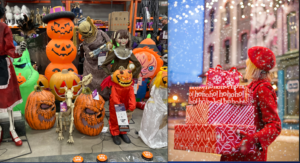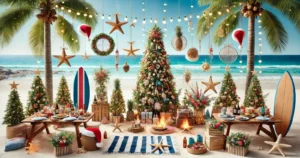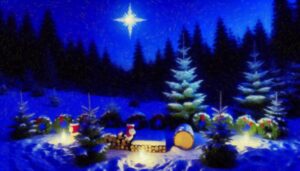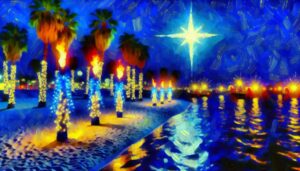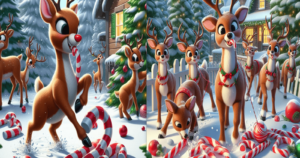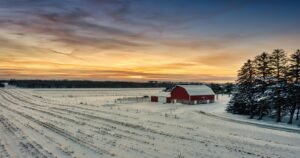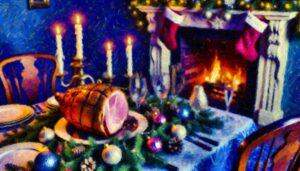Ever wonder how many weeks are left until Christmas? Lets Calculate and enjoy the planning and preparations.
Christmas is an annual festival commemorating the birth of Jesus Christ, observed primarily on December 25th as a religious and cultural celebration among billions of people around the world.
It is a central part of the Christian liturgical year and is preceded by the season of Advent and initiates the season of Christmastide, which historically in the West lasts twelve days and culminates on Twelfth Night.
In some traditions, the Christmas season continues until the Feast of the Presentation of Jesus at the Temple on February 2nd, also known as Candlemas.

How to Use the Custom countdown Calculator
1. In the Select a date field you choose the Target date you want to calculate. Example ( you want to calculate Christmas day you enter 12/25/2024 ).
2. Hit Calculate countdown button and It will give you the days, hours ,minutes and seconds left before Target date arrives.
3. This Calculator can also keep tract of important date during the Holidays. for example let say you have a Christmas party set for 12th December 2024. You can enter that date in the Select a date field and it will give you the days ,hours, minutes and seconds before your party.
How to Calculate the Weeks Left Until Christmas
- Identify Today’s Date:
- First, note today’s date. For example, let’s say today is June 29, 2024.
- Identify Christmas Date:
- Christmas is celebrated on December 25th each year.
- Calculate the Number of Days Until Christmas:
- Determine the number of days from today until December 25th. This can be done by counting the days remaining in each month and adding them up.
- For example, from June 29 to December 25:
- Days remaining in June: 30 – 29 = 1 day
- Days in July: 31 days
- Days in August: 31 days
- Days in September: 30 days
- Days in October: 31 days
- Days in November: 30 days
- Days in December: 25 days (since we stop at the 25th)
- Total days = 1 + 31 + 31 + 30 + 31 + 30 + 25 = 179 days
- Convert Days to Weeks:
- There are 7 days in a week. To convert the total number of days into weeks, divide the number of days by 7.
- Weeks=179/7=25.57 weeks
- So, there are approximately 25 weeks and 4 days until Christmas from June 29, 2024.
Important Dates and Activities leading up to Christmas from November 1st.
| Date | Event/Activity |
|---|---|
| November 1 | All Saints’ Day |
| First Week of November | Start Holiday Shopping, Plan Holiday Travel |
| November 11 | Veterans Day (U.S.) |
| Mid-November | Decorate Your Home, Bake Holiday Treats |
| Fourth Thursday of November | Thanksgiving (U.S.) |
| Day after Thanksgiving | Black Friday |
| November 30 | St. Andrew’s Day (Scotland) |
| December 1 | Start of Advent Calendar |
| First Sunday of Advent | Beginning of Advent season (date varies) |
| First Week of December | Send Christmas Cards, Attend Christmas Tree Lightings |
| December 6 | St. Nicholas Day |
| Second Week of December | Decorate the Christmas Tree |
| December 13 | St. Lucia Day a festival of lights |
| Third Week of December | Wrap Gifts, Attend Holiday Concerts and Plays |
| December 21 | Winter Solstice |
| December 24 | Christmas Eve: Final Preparations, Church Services, Family Gatherings |
| December 25 | Christmas Day: Gift Exchanges, Festive Meals, Family Gatherings |
November
- November 1 – All Saints’ Day:
- A Christian holiday honoring all saints, known and unknown.
- First Week of November:
- Start Holiday Shopping:
- Begin planning and shopping for gifts to avoid last-minute rush.
- Plan Holiday Travel:
- Make travel arrangements if you plan to visit family or friends.
- Start Holiday Shopping:
- November 11 – Veterans Day (U.S.):
- A day to honor military veterans.
- Mid-November:
- Decorate Your Home:
- Start putting up holiday decorations, including lights and outdoor displays.
- Bake Holiday Treats:
- Begin baking and preparing holiday treats and cookies.
- Decorate Your Home:

5. Fourth Thursday of November – Thanksgiving (U.S.):
- A major holiday in the U.S. celebrating gratitude with a feast.
- Black Friday (Day after Thanksgiving):
- Major shopping day with sales and promotions.
6. November 30 – St. Andrew’s Day (Scotland):
- Scotland’s national day, celebrating St. Andrew, the patron saint of Scotland.
December
- December 1 – Start of Advent Calendar:
- Open the first door on your advent calendar to count down to Christmas.
- First Sunday of Advent:
- Marks the beginning of the Advent season in the Christian calendar (date varies, usually the last Sunday in November or first in December).
- First Week of December:
- Send Christmas Cards:
- Write and send Christmas cards to friends and family.
- Attend Christmas Tree Lightings:
- Participate in local tree lighting ceremonies and festivals.
- Send Christmas Cards:
- December 6 – St. Nicholas Day:
- Celebrate the feast day of St. Nicholas, the patron saint of children.
- Second Week of December:
- Decorate the Christmas Tree:
- Put up and decorate the Christmas tree with ornaments and lights.
- Decorate the Christmas Tree:
- December 13 – St. Lucia Day:
- A festival of lights celebrated in Scandinavia.
- Third Week of December:
- Wrap Gifts:
- Wrap and label all your holiday gifts.
- Attend Holiday Concerts and Plays:
- Enjoy performances such as “The Nutcracker” or holiday-themed concerts.
- Wrap Gifts:
- December 21 – Winter Solstice:
- The shortest day and longest night of the year.
- December 24 – Christmas Eve:
- Final preparations for Christmas Day.
- Attend Christmas Eve church services.
- Traditional family gatherings and festive meals.
- December 25 – Christmas Day:
- Celebrate Christmas with gift exchanges, festive meals, and family gatherings.
Additional Activities Throughout November and December:
- Holiday Markets:
- Visit local holiday markets to shop for unique gifts and enjoy festive foods.
- Charity and Volunteering:
- Participate in charitable activities, such as toy drives and food bank donations.
- Holiday Movie Nights:
- Watch classic holiday movies with family and friends.
- Crafting Decorations:
- Create homemade decorations and ornaments.
- Outdoor Activities:
- Enjoy winter activities such as ice skating, sledding, or visiting a Christmas tree farm.
By following these dates and activities, you can fully immerse yourself in the festive spirit and ensure a well-prepared and joyous Christmas season.
Important dates and activities leading up to Christmas around the world starting from November 1st:

November
| Date | Event/Activity |
|---|---|
| November 1 | All Saints’ Day (celebrated in many Caribbean countries) |
| November 2 | All Souls’ Day (observed in some Caribbean countries) |
| Mid-November | Begin Holiday Shopping and Planning |
| Third Week of November | Various cultural festivals and events |
| Fourth Thursday of November | Thanksgiving (U.S. territories like Puerto Rico) |
| Day after Thanksgiving | Black Friday Sales |
| Last Week of November | Begin Decorating Homes and Public Spaces for Christmas |

December Event /Activity
| Date | Event/Activity |
|---|---|
| First Sunday of December | Advent Season Begins (varies, usually last Sunday in November or first in December) |
| December 1 | Start of Advent Calendar |
| Early December | Attend Christmas Markets and Bazaars |
| December 6 | St. Nicholas Day |
| Second Week of December | Participate in Community Christmas Events |
| December 12 | Fiesta de la Virgen de Guadalupe (observed in some areas) |
| December 13 | St. Lucia Day (observed in Sweden and some other areas). |
| Mid-December | Attend and Host Christmas Parties |
| December 16-24 | -Las Posadas (celebrated in Puerto Rico and other areas) –Nine Mornings Celebrations in St Vincent & the Grenadines. –Simbang Gabi– In the Philippines A series of nine pre-dawn masses, culminating in the Midnight Mass on Christmas Eve. |
| December 21 | Winter Solstice |
| December 24 | Christmas Eve: Midnight Mass, Family Gatherings, Festive Meals |
| December 25 | Christmas Day: Celebrations with Family, Gift Exchanges, Festive Meals |
| December 26 | Boxing Day (celebrated in most Caribbean countries that was colonies by the British) |
| December 31 | New Year’s Eve: Local Caribbean people refers to as “OLD YEARS DAY” Celebrations and Fireworks |
Additional Activities Throughout November and December:
- Music and Dance Festivals: In the Caribbean Enjoy local music genres such as reggae, calypso, soca, and dancehall.
- Parrandas and Parang Music: Participate in traditional Christmas caroling and music in Puerto Rico and Trinidad and Tobago.
- Charity and Volunteering: Engage in community service, such as toy drives and food donations.
- Holiday Food Preparations: Prepare traditional Caribbean Christmas dishes such as black cake, pasteles, and sorrel drink.
- Beach and Outdoor Activities: Take advantage of the warm weather with beach outings and outdoor festivities.
- Crafting and Decorating: Create homemade decorations, including Caribbean-themed ornaments and crafts.
Christmas Planner: December 1 – December 25 Planner
December 1-5: Decoration & Planning

- Dec 1: Decorate the house. Put up the Christmas tree and hang wreaths.
- Dec 2: Make a holiday budget and gift list.
- Dec 3: Start shopping for gifts online or in stores.
- Dec 4: Create a holiday card list and start writing cards.
- Dec 5: Plan holiday meals and make a grocery list.
December 6-10: Activities & Crafts
- Dec 6: Bake Christmas cookies or other holiday treats.
- Dec 7: Craft DIY Christmas ornaments.
- Dec 8: Attend a local holiday event or market.
- Dec 9: Make a gingerbread house with family or friends.
- Dec 10: Watch a classic Christmas movie.
December 11-15: Giving & Sharing
- Dec 11: Donate to a local charity or volunteer.
- Dec 12: Send out holiday cards.
- Dec 13: Wrap presents and add personalized tags.
- Dec 14: Host a holiday party or small gathering.
- Dec 15: Make a special dinner for your loved ones.
December 16-20: Self-Care & Relaxation
- Dec 16: Take a winter walk and enjoy the decorations in your neighborhood.
- Dec 17: Have a spa day at home.
- Dec 18: Read a holiday-themed book.
- Dec 19: Listen to Christmas music and relax.
- Dec 20: Make a hot chocolate bar with various toppings.

December 21-24: Final Preparations
- Dec 21: Do a final grocery run for Christmas Day.
- Dec 22: Prepare dishes that can be made ahead of time.
- Dec 23: Finish any last-minute shopping.
- Dec 24: Set the table and prep for Christmas Day.
December 25: Christmas Day
- Dec 25: Celebrate with family and friends. Enjoy a festive meal, open gifts, and create lasting memories.
Traditional Christmas Countdown & festivals Around the World
Europe

Germany: Advent Calendars
- Description: The Advent calendar, a popular tradition originating in Germany, helps children count down the days to Christmas. Each day reveals a small gift or treat.
The concept of counting down the days to Christmas started in German Protestant communities. Families would mark the days from December 1st to December 24th with chalk marks on doors or by lighting candles. Some families would hang a religious picture for each day or draw a line on the wall to help children visualize the passage of time until Christmas.
Sweden: St. Lucia Day
- Description: Celebrated on December 13th, St. Lucia Day marks the beginning of the Christmas season in Sweden. Girls dress in white robes with red sashes and wear crowns of candles.
Christmas in Italy
In Italy, Christmas is a deeply traditional and family-oriented celebration. It kicks off with the Feast of the Immaculate Conception on December 8th, when decorations and nativity scenes are set up. The nativity scene (presepe) is a central part of Italian Christmas, with many towns displaying elaborate versions. Christmas Eve is marked by a special dinner, often featuring seafood, and Midnight Mass. Christmas Day is for family gatherings and feasting on dishes like roasted meats and panettone, a sweet bread. The festive season concludes on January 6th with the Epiphany, celebrated with the arrival of La Befana, a kind witch who brings gifts to children.
Christmas in Spain
In Spain, Christmas celebrations begin on December 22nd with the famous Christmas lottery, El Gordo. Christmas Eve, known as Nochebuena, is a major event with a large family dinner and Midnight Mass, or La Misa del Gallo (Rooster’s Mass).
Traditional foods include seafood, lamb, and turrón, a nougat confection. Christmas Day is a time for family and relaxation. The season extends to January 6th, Epiphany, known as Día de los Reyes (Three Kings’ Day), when children receive gifts. Parades and celebrations on the eve of Epiphany are a highlight, with the Three Kings distributing sweets and presents.
Christmas in France
In France, Christmas is celebrated with a mix of religious and secular traditions. The season starts with Advent, and towns are adorned with lights and decorations. On Christmas Eve, many families attend Midnight Mass, followed by a grand feast called Le Réveillon. This meal includes delicacies like foie gras, oysters, roasted meats, and the bûche de Noël (Yule log cake).
Christmas markets, particularly in regions like Alsace, are popular for holiday shopping and festive foods. Christmas Day is spent with family, exchanging gifts and enjoying meals. The festive period continues to January 6th, with the Epiphany celebrated by eating a galette des rois (King’s cake).
United Kingdom: Christmas Crackers
- Description: Christmas crackers, traditionally used during Christmas dinner, contain small gifts, jokes, and paper crowns.
- History: Christmas crackers, a staple of holiday celebrations in the United Kingdom and other parts of the world, were invented by Tom Smith, a London confectioner, in the 19th century. The story of their origin is both creative and entrepreneurial.
The Inception of the Christmas Crackers
In 1847, Tom Smith, inspired by a trip to Paris, sought to popularize a French concept he had encountered: the bonbon. Bonbons were sugared almonds wrapped in a twist of tissue paper. Seeing potential in this idea, Smith began selling similar sweets in London, but with a twist – he included a small motto or riddle within the wrapping.
The Evolution
The bonbons sold well, but Smith wanted to create something more exciting, especially for the Christmas market. Legend has it that the inspiration for the “crack” came from the sound of a log crackling in his fireplace. He thought of adding a bang to the sweet, making it more appealing, especially to children.
The Creation
After experimenting with various methods, Smith finally devised a way to make the bonbons “crack” when pulled apart. This was achieved by incorporating a strip of chemically impregnated paper that produced a small explosion when pulled. Thus, the first “crackers” were born.
The Transformation
The initial crackers contained the sweet, a motto or riddle, and the distinctive crack. Over time, the design evolved. By the late 19th century, the sweets were replaced with small gifts, such as trinkets or toys, and the mottos expanded to include jokes, puzzles, and paper hats. The traditional elements of the Christmas cracker – a bang, a hat, a joke, and a small gift – were established.

Russia: Svyatki and Ded Moroz
- Description: In Russia, the Christmas season includes Svyatki, celebrated from January 7th to 19th, with Ded Moroz (Grandfather Frost) bringing gifts.
- Traditions: Explain the customs, such as fortune-telling and traditional feasts, during this period.
North America

United States: Elf on the Shelf, Advent Calendar and festive lights
- Description: A relatively recent tradition where a toy elf is placed around the house to “watch” children and report to Santa.
- Engagement: Families would move the elf to different locations each night, creating a sense of magic and anticipation.
- Advent calendars: Similar to Germany, many USA families use Advent calendars to count down to Christmas, with small gifts or treats for each day of December.
Canada: Advent Calendars and Festive Lights
- Advent Calendars: Similar to Germany, many Canadian families use Advent calendars to count down to Christmas, with small gifts or treats for each day of December.
- Festive Lights and Displays: A prominent tradition in Canada is the extensive decoration of homes and neighborhoods with festive lights and displays. Communities often hold lighting ceremonies and competitions.

- Cultural Blend: Highlight the multicultural aspect of Canadian Christmas celebrations, incorporating traditions from various cultures, including British, French, and Indigenous influences.
Alaska: Star Singers
- Description: In Alaska, especially among the Russian Orthodox communities, groups of “Star Singers” go from house to house singing carols.
- Winter Traditions: Despite the darkness, many communities embrace outdoor winter activities such as ice skating, sledding, and attending light festivals. These activities can be magical under the night sky, contributing to a unique and joyful holiday experience.
- The most delightful of cold weather celebrations is the Winter Solstice, observed on December 21st. On this day, people living in the Far North joyfully celebrate the return of the light.
Central and South America

Mexico: Las Posadas
- Description: Las Posadas, celebrated from December 16th to 24th, reenacts Mary and Joseph’s search for lodging in Bethlehem.
- Cultural Significance: Describe the nightly processions, songs, and celebrations that culminate in a festive party with piñatas and food.
Colombia: Novena de Aguinaldos
- Description: A nine-day religious observance leading up to Christmas, with families gathering to pray, sing carols, and share meals.
- Community Aspect: Highlight the communal nature of the Novena, fostering family and neighborhood bonds.
Venezuela: Roller Skating to Mass
- Description: In Caracas, it is traditional to roller skate to early morning Mass during the Christmas season.
- Unique Tradition: Explain the joy and community spirit behind this unusual and vibrant tradition.
Peru: Chocolatadas
- Description: During December, communities in Peru gather for “chocolatadas,” where hot chocolate and sweet bread are shared, especially with those in need.
- Cultural Importance: Highlight the emphasis on charity and community during these gatherings.
Asia

Philippines: Simbang Gabi
- Description:Simbang Gabi is a cherished Filipino Christmas tradition, involving a series of nine dawn masses leading up to Christmas Eve. The name “Simbang Gabi” translates to “Night Mass,” though it is also known as “Misa de Gallo,” meaning “Rooster’s Mass,” because these masses traditionally begin as early as 4 AM, coinciding with the crowing of roosters.
- Traditions: This tradition dates back to the Spanish colonial period in the Philippines. It has become a cultural event that highlights the deep-rooted Catholic faith and the unique ways Filipinos celebrate their spirituality.
Festive Meals After Mass
Following the early morning mass, it’s customary to enjoy festive meals that feature traditional Filipino delicacies. Two popular treats are bibingka and puto bumbong:
- Bibingka: A type of rice cake made from glutinous rice, coconut milk, and eggs, typically baked in clay pots lined with banana leaves. It is often topped with salted egg, cheese, and grated coconut. Bibingka is soft, slightly sweet, and has a distinct smoky flavor due to the traditional cooking method.
- Puto Bumbong: Another rice cake delicacy made from purple glutinous rice, traditionally steamed in bamboo tubes, which gives it its cylindrical shape and unique texture. Puto bumbong is usually served with butter or margarine, grated coconut, and muscovado sugar, creating a delightful mix of flavors and textures.
Japan: Christmas Eve Celebrations
- Description: Christmas Eve in Japan is often celebrated more like Valentine’s Day, with couples going out for romantic dinners and exchanging gifts.
- Modern Twist: Discuss the influence of Western culture and the unique Japanese spin on Christmas celebrations.
India: Midnight Mass and Community Feasts
- Description: In India, Christmas celebrations include attending Midnight Mass and sharing community feasts.
- Cultural Diversity: Highlight how different regions of India celebrate with local flavors and customs, such as lighting oil lamps and decorating mango or banana trees.
China: Christmas Apples
- Description: In China, it is customary to gift decorated apples on Christmas Eve, symbolizing peace.
- Emerging Tradition: Discuss the growing popularity of Christmas in urban areas and the blending of local traditions with Western influences.
Africa

Ethiopia: Genna
- Description: Ethiopian Orthodox Christians celebrate Christmas, or Genna, on January 7th with a 43-day fast preceding the holiday.
- Celebrations: Describe the traditional Genna games, similar to hockey, and the festive church services.
Nigeria: Festivals and Masquerades
- Description: Christmas in Nigeria includes vibrant festivals and masquerades, with communities celebrating together.
- Rich Cultural Heritage: Highlight the mix of Christian and indigenous traditions that make Nigerian Christmas celebrations unique.
South Africa: Braai and Beach Outings
- Description: South Africans often celebrate Christmas with a “braai” (barbecue) and outings to the beach.
- Seasonal Twist: Explain how the summer season influences Christmas activities and gatherings.
Morocco: Festive Meals and Family Gatherings
- Description: While Christmas is not widely celebrated, Moroccan Christians observe it with festive meals and family gatherings.
- Cultural Sensitivity: Discuss the interfaith harmony and respect during the holiday season.
Central Africa: Communal Feasts and Church Services
- Description: In Central African countries, communal feasts and church services are central to Christmas celebrations.
- Community Focus: Emphasize the importance of community and shared joy in these traditions.
Middle East

Israel: Christian Pilgrimages and Midnight Mass
- Description: In Israel, Christian pilgrims visit Bethlehem and attend Midnight Mass at the Church of the Nativity.
- Spiritual Significance:For Christians, Bethlehem is revered as the birthplace of Jesus Christ, marking it as a central location for the nativity story. The Church of the Nativity, built over the site traditionally considered Jesus’ birthplace, becomes a focal point for pilgrims from around the world.
The celebration in the Holy Land is not only a religious observance but also a powerful connection to the roots of Christian faith, embodying centuries of tradition, history, and spiritual reflection. The events, including midnight mass and processions, symbolize the universal message of peace and goodwill central to the Christmas story.
Middle East: Cultural Celebrations
In many Middle Eastern countries, interfaith respect and peaceful coexistence are important aspects of daily life, especially during the holiday season. Here are some ways in which this respect and coexistence are demonstrated:
Examples:
- Lebanon: Known for its religious diversity, Lebanon often sees joint celebrations and mutual respect among Christians, Muslims, and Druze communities, especially during Christmas and Ramadan.
- United Arab Emirates: The UAE promotes tolerance and has established a Ministry of Tolerance. During holidays like Ramadan and Christmas, there are numerous public and private events that emphasize interfaith harmony.
- Jordan: Jordan is home to various religious groups, and the country often sees public displays of mutual respect during religious holidays. The royal family and government officials frequently send greetings to different communities, fostering a sense of unity.
The peaceful coexistence and respect for different religious traditions during the holiday season in the Middle East are a testament to the region’s rich cultural tapestry and its commitment to fostering a harmonious society.
Oceania

Australia: Carols by Candlelight
- Description: A unique Australian tradition where people gather in parks and outdoor spaces to sing Christmas carols by candlelight.
- Christmas in Australia is celebrated during the summer, with temperatures often reaching well into the 30s Celsius (around 86°F and above). Australians enjoy outdoor activities such as barbecues, beach outings, and sporting events.
- Traditional Christmas decorations include Christmas trees, lights, and ornaments, similar to those used in the Northern Hemisphere, but with a unique Australian twist, such as native flora like the Christmas Bush and Christmas Bells.
- Christmas Day typically involves a festive meal, which can range from a traditional roast dinner to a seafood feast, reflecting the country’s multicultural influences. Pavlova, a meringue-based dessert topped with fresh fruit, is a popular treat.
- Carols by Candlelight events are held in many cities and towns, where people gather outdoors to sing Christmas carols by candlelight. Boxing Day, the day after Christmas, is also significant, featuring major sporting events like the Boxing Day Test cricket match and the Sydney to Hobart Yacht Race.
Solomon Islands: Church Services and Communal Meals
- Description: In the Solomon Islands, Christmas is marked by church services and communal meals.
- Traditional Foods: In the Solomon Islands, Christmas celebrations are rich with unique local foods and customs, reflecting the island’s diverse culture and traditions. Here are some key aspects:
- Foods
- Fish and Seafood: Being an island nation, fish and seafood are staples. Freshly caught fish, often grilled or cooked in coconut milk, is a common feature of Christmas meals.
- Taro and Cassava: These root vegetables are essential in many dishes. They are often boiled, roasted, or made into puddings.
- Kokoda: A popular dish, Kokoda is a type of ceviche made with raw fish marinated in lime juice and coconut milk, mixed with onions, tomatoes, and chili.
- Chicken and Pork: Roasted or spit-roasted chicken and pork are popular for Christmas feasts.
- Fruit and Vegetables: Tropical fruits like bananas, papayas, and pineapples, along with vegetables like sweet potatoes and greens, are commonly served.
- Desserts: Desserts often include local ingredients like coconut and tropical fruits. Cassava pudding, often sweetened with coconut cream and sugar, is a favorite.
- Customs
- Church Services: Attending church services is a central part of Christmas celebrations. These services are filled with singing, dancing, and the retelling of the nativity story.
- Carol Singing: Groups of people often go caroling from house to house, spreading festive cheer.
- Traditional Dances: Traditional dances, performed in colorful costumes, are a vibrant part of the celebrations.
- Gift Giving: Exchanging gifts is a common practice, often including handmade items or locally produced goods.
- Community Feasts: Villages often come together for communal feasts, where food is shared among everyone, fostering a strong sense of community.
- Decorations: Homes and churches are decorated with flowers, palm leaves, and other natural materials.
These foods and customs create a festive atmosphere that combines traditional practices with the celebration of Christmas, making it a unique and cherished time in the Solomon Islands.
Guam: Light Festivals and Parades
- Description: In Guam, Christmas is celebrated with light festivals, parades, and traditional Chamorro dances.
Traditional Chamorro Elements:
- Lanterns and Decorations:
- Chamorro people incorporate traditional materials and designs into their Christmas decorations. Handcrafted lanterns (parols) made from bamboo and paper often feature traditional patterns and symbols.
- Music and Dance:
- Christmas celebrations include traditional Chamorro music and dance performances, such as the “Bailan Chamorro.” These dances are performed during festive gatherings, combining traditional rhythms with holiday themes.
- Fiestas and Gatherings:
- Community fiestas are a staple of Chamorro culture. During Christmas, these gatherings are enhanced with traditional foods, music, and dances, creating a communal and festive atmosphere.
Resources
https://www.explorefairbanks.com/blog/post/a-snow-globe-solstice
https://tourism.gov.vc/tourism/index.php/festivals-a-events/66-nine-mornings-festival
https://en.wikipedia.org/wiki/Advent_calendar
https://www.whychristmas.com/cultures

